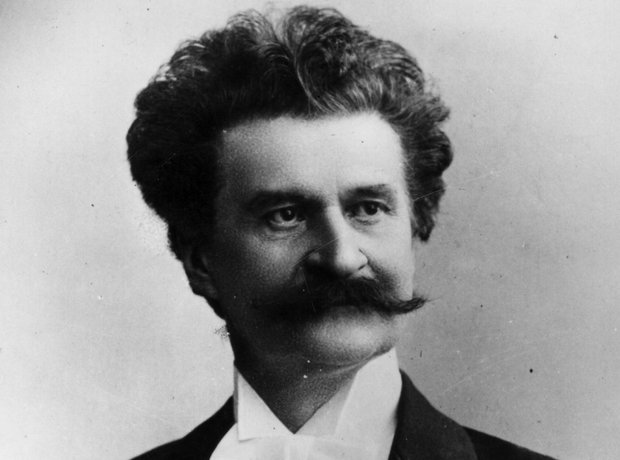
“Persian March,” the brilliant work by Austrian composer Johann Strauss, with an inquisitive gaze toward the mysterious East, has managed to intertwine the sounds of distant lands with the delicacy and spirit of Viennese music — and it still remains a beautiful bridge between cultures and languages.
Tehran Symphony Orchestra to Perform Johann Strauss II’s “Persian March” in One of Its Most Stirring Concerts
On Tuesday, November 5 (15th of Aban), the Tehran Symphony Orchestra is set to present one of its most passionate performances to date, featuring “Persian March”, a brilliant work by Johann Strauss II—the undisputed king of the waltz—under the baton of guest conductor Maziar Younesi. In this piece, the Austrian composer, with a curious and searching gaze toward the mysterious East, masterfully intertwines the sounds of distant lands with the grace and spirit of Viennese music. First gaining fame during the 1873 Vienna World’s Fair, this piece still serves as a beautiful bridge between cultures and languages—an anthem that awakens in every listener a sense of reverence and discovery.
In this article, we will take a deeper look at “Persian March” and its creator, Johann Strauss, to explore how this genius composer captured the essence of Iran and echoed it in the heart of Vienna through a timeless composition.
Johann Strauss II, often referred to as the “Waltz King,” was one of Austria’s foremost Romantic-era composers, renowned especially for his dance music, operettas, and, most famously, his waltzes. Born on October 25, 1825, in Vienna, into a musically gifted family, his father—Johann Strauss I—was also a well-known composer. However, their relationship was fraught with tension. Nevertheless, Strauss the younger ultimately surpassed his father in fame and artistic achievement, elevating the waltz from a popular dance form to a refined and cherished art.
Among Strauss II’s most famous works are “The Blue Danube” (An der schönen blauen Donau), often considered Austria’s unofficial national anthem, “Tales from the Vienna Woods”, “Voices of Spring”, and the “Emperor Waltz”. He also composed beloved operettas such as “Die Fledermaus” (The Bat) and “The Gypsy Baron”. These pieces reflect the vibrant spirit of Vienna with their enchanting rhythms, memorable melodies, and infectious liveliness.
Throughout his life, Strauss composed more than 500 dance works, including polkas, quadrilles, and waltzes, as well as several operettas. His ability to express Viennese culture and enrich the waltz form left a lasting legacy in classical music. He became a celebrated figure in Vienna, and his music remains a staple of the Vienna Philharmonic’s annual New Year’s Concert. Johann Strauss II died on June 3, 1899, but his works continue to be performed and revered around the world, securing his place as one of the most influential composers in classical music history.

Strauss composed “Persian March” in 1864 as a lively and festive piece to honor Naser al-Din Shah Qajar, the King of Persia, who visited Vienna during a European tour. The march exudes an “Oriental” mood, blending Middle Eastern musical aesthetics with Strauss’s distinct Viennese style. This exotic flair was particularly popular in 19th-century Europe, a time of heightened fascination with the cultures of the Middle East and Asia.
“Persian March” is a vibrant and energetic work, full of spirited rhythms and delicate melodies, showcasing the grandeur of Strauss’s musical imagination. The piece was warmly received in Vienna and quickly became one of Strauss’s favored compositions. It also highlights his unique ability to merge the martial energy of a march with the charm and grace of a dance.
The march gained particular prominence during the 1873 Vienna World’s Fair, a major event that showcased cultural and technological achievements from around the globe. Strauss’s music, including “Persian March”, symbolized the richness of Viennese culture and served as a cultural highlight of the exposition. This period marked the height of Strauss’s popularity, as his works introduced international audiences to the elegance of Viennese music.
The inspiration for the march came from Strauss’s experimentation with Middle Eastern musical elements, reflecting a broader European trend of Orientalism in the arts and literature of the time. His interest in foreign lands and cultures led him to ornament the march with rhythms and melodies that evoked a sense of the exotic and faraway—though always within the frame of traditional Viennese composition. This approach mirrored the Romantic-era’s idealized and imaginative view of the East.
“Persian March” still stands as a symbolic bridge between Western and Iranian cultures, illustrating how music can serve as a powerful tool for cultural diplomacy. The piece continues to be performed at New Year’s concerts and other international classical music events, maintaining its popularity and recognition as one of Strauss’s finest compositions inspired by international themes.
Now, all eyes turn to the Tehran Symphony Orchestra as it prepares to bring “Persian March”—a work inspired by this very land—back to life on Iranian soil. Will this performance, led by the skilled baton of Maziar Younesi, become one of the most memorable interpretations of this march? Can it etch a lasting mark in the history of the country’s musical heritage?
Written By Farid Parish
